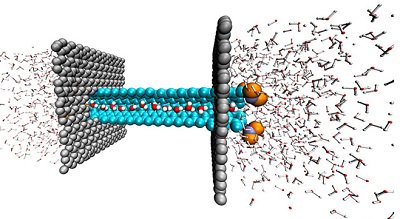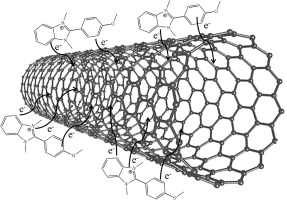Ability to store energy in nanotubes many times the volume of graphite electrodes (PhD in nano-microelectronics)
Researcher and author: Dr. ( Afshin Rashid)
Note: In nanotubes, all three carbon atoms can store one lithium ion, while in graphite, all six carbon atoms can store one lithium ion. Also, the ability to store energy in nanotubes is many times the volume of graphite electrodes.
A lot of hydrogen can be stored in nanotubes for energy applications and fuel cocoons. Have become superconducting. The radius of these superconducting nanotubes is only 6.4 nanometers. Phase transfer in one or two dimensional systems where room temperature superconductivity can be found in carbon nanotubes and graphene particles and is based on room temperature conductivity. Electric voltage is generated by the passage of liquid through coils of single-walled carbon nanotubes. This technique is used to build fluid flow sensors to detect very small amounts of fluids and to generate voltage in biomedical applications . Also, liquids with high ionic strength produce more voltage . The rate of increase in heat output and resistance of nanotubes is proportional to the third root of the mass of atoms and molecules. also Heating increases the strength of the nanotube and increases its tensile strength sixfold and increases its conductivity . When atoms or molecules collide with carbon nanotubes, their electrical resistance changes.
Arc discharge method
In this method, carbon atoms are heated and evaporated inside a helium gas plasma by passing a high current through the two poles of the anode and cathode . The arc method is the most common and perhaps the simplest method for the production of carbon nanotubes, in which a mixture of nanotubes and impurities is produced, which separates the nanotubes from soot and metals . Talisman in the raw product is essential. In this method, nanotubes are produced by evaporating an electric arc of two carbon rods facing each other at approximately 1 mm apart. The electrodes are housed in a chamber filled with an inert gas (helium or argon) at a relatively low pressure of 766-56 mbar. Creating a potential of about 26 volts with a current in the range of 166-56 amps causes an electrical discharge in the gas at high temperature and the heat from the discharge, one Evaporate from the carbon electrodes and precipitate in the form of small rods on the other electrode.
Conclusion :
Electronic storage (superconductivity) in carbon nanotubes and graphene particles has made nanotubes an ideal choice for many applications. The existence of a series of special coordinates of carbon nanotubes makes them useful in Tool making is centralized, and they will be able to make a very wide range of industrial tools.
Researcher and author: Dr. ( Afshin Rashid)
PhD in Nano-Microelectronics




